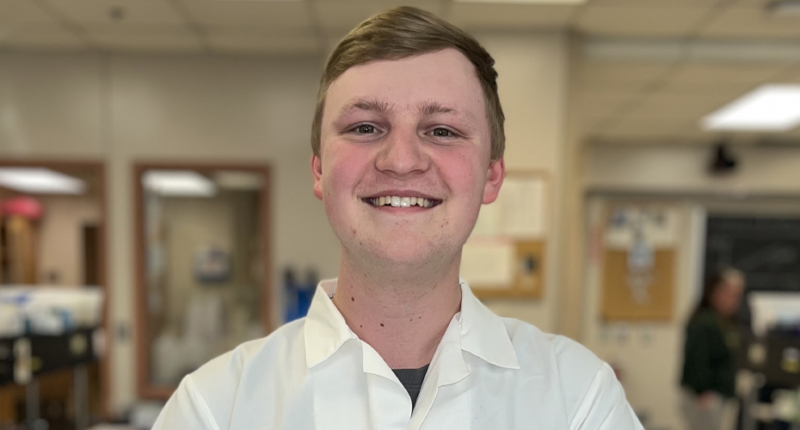Braden Lewis, a junior in the biochemistry department at Iowa State University (ISU), combined his love for football and science to develop an innovative biochemistry technique for food preservation. His research is focused on improving pathogen reduction methods for the food industry. Lewis combined two methods – high-voltage atmospheric cold plasma (HVACP) and cinnamaldehyde – to reduce bacterial content in pineapple juice. His combination strategy has the potential to revolutionize food preservation methods, making them safer, more natural, and more appealing to consumers. Lewis showcased his innovative food preservation technique at the Discovery BMB conference in Seattle and plans to pursue a Ph.D. after graduation with the goal of becoming a professor. He is a teaching assistant for a biochemistry course and a peer mentor and encourages other undergrads to be open to trying anything. Aubrey Mendonça, Lewis’ mentor, advises students that good professors can demystify complex topics and make learning a pleasurable experience.
A Love for Football and Science Inspired Undergrad’s Innovative Research in Food Preservation
Braden Lewis, a junior in the biochemistry department at Iowa State University (ISU), has combined his love for football with his passion for science to create an innovative biochemistry technique for food preservation. Lewis, a lifelong lover of science and ISU football fan, joined Aubrey Mendonça’s lab as a first-year honors student, where he began supporting graduate students before being hired as an undergraduate researcher.
Lewis’ research is focused on improving pathogen reduction methods for the food industry. While pasteurization, canning, and antimicrobial compounds are widely used to preserve food, these established techniques can sometimes impact the flavor and nutritional value of the food. Furthermore, chemical preservatives can also discourage consumers. In light of these challenges, Mendonça’s lab is exploring the use of nonthermal technologies and natural antimicrobials and preservatives to make food preservation safer, more natural, and more consumer-friendly.
In developing his own research project, Lewis combined two methods – high-voltage atmospheric cold plasma (HVACP) and cinnamaldehyde. HVACP is a processing technique that applies an electric field to atmospheric air to create reactive oxygen and nitrogen species that kill bacteria without affecting the food’s essential nutrients or raising its temperature. Cinnamaldehyde, a natural chemical compound that gives cinnamon its flavor and odor, is known to have antimicrobial properties.
Lewis compared his research to offensive strategies in football games, where running and passing are combined to move the ball effectively. In the same way, Lewis combined HVACP and cinnamaldehyde to reduce bacterial content from “millions to 10 or less in just a few minutes” in pineapple juice, preserving the food and retaining nutrients without using heat or harsh chemical interventions.
Overall, Lewis’ combination strategy has the potential to revolutionize food preservation methods, making them safer, more natural, and more appealing to consumers.
Undergrad’s Innovative Food Preservation Technique Showcased at Conference
Braden Lewis was eager to share his innovative food preservation technique with others at the Discovery BMB conference in Seattle. As a teaching assistant for a biochemistry course and a peer mentor, Lewis encourages other undergrads to be open to trying anything, even if they end up discovering they don’t enjoy a particular topic. Lewis plans to pursue a Ph.D. after graduation with the goal of becoming a professor.
Lewis’ mentor, Aubrey Mendonça, also offers words of advice for students. Good professors can demystify complex topics and make learning a pleasurable experience, as Mendonça did for Lewis. Although Lewis is a biochemistry major, he never believed he would enjoy microbiology and is now considering a minor in the subject.
Don’t miss interesting posts on Famousbio









